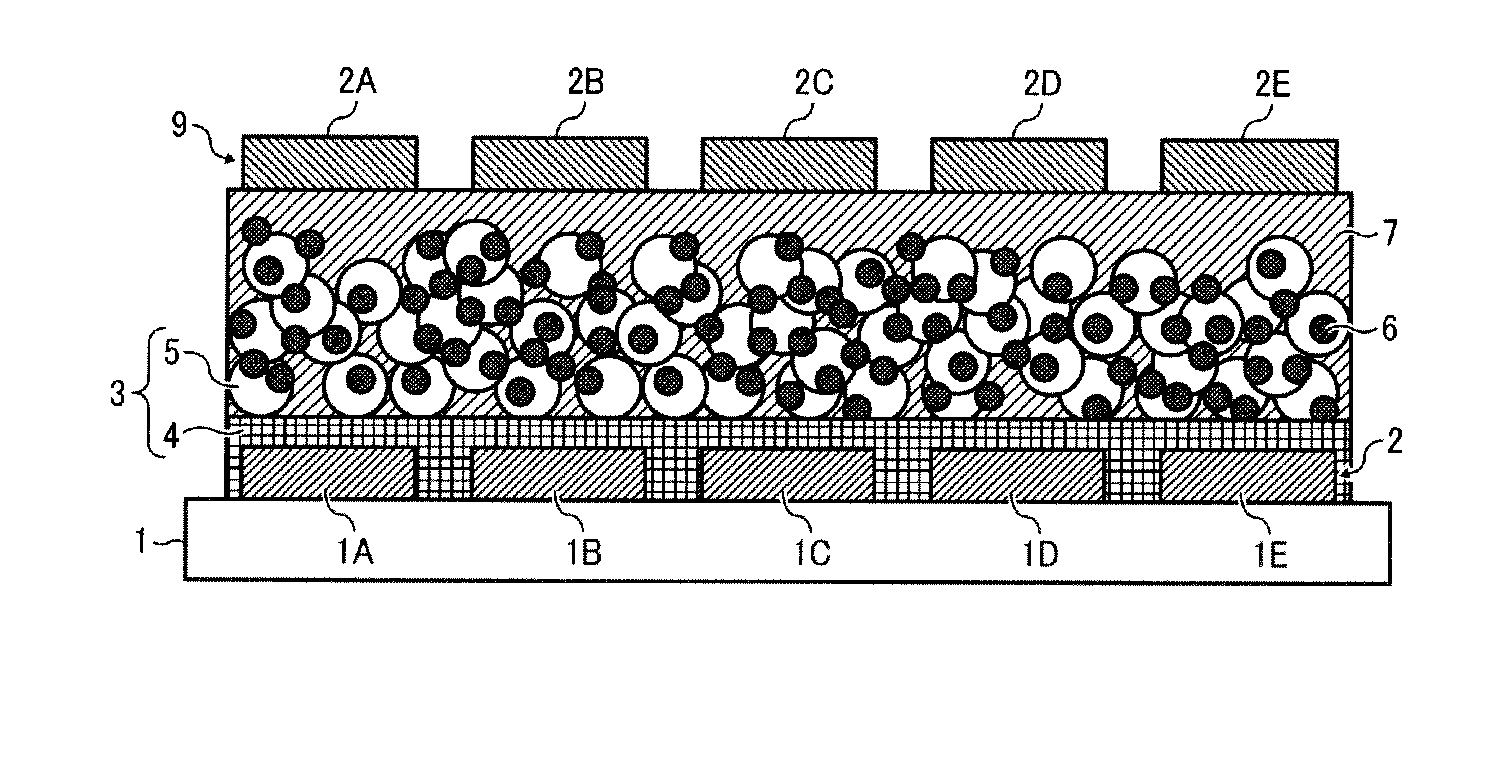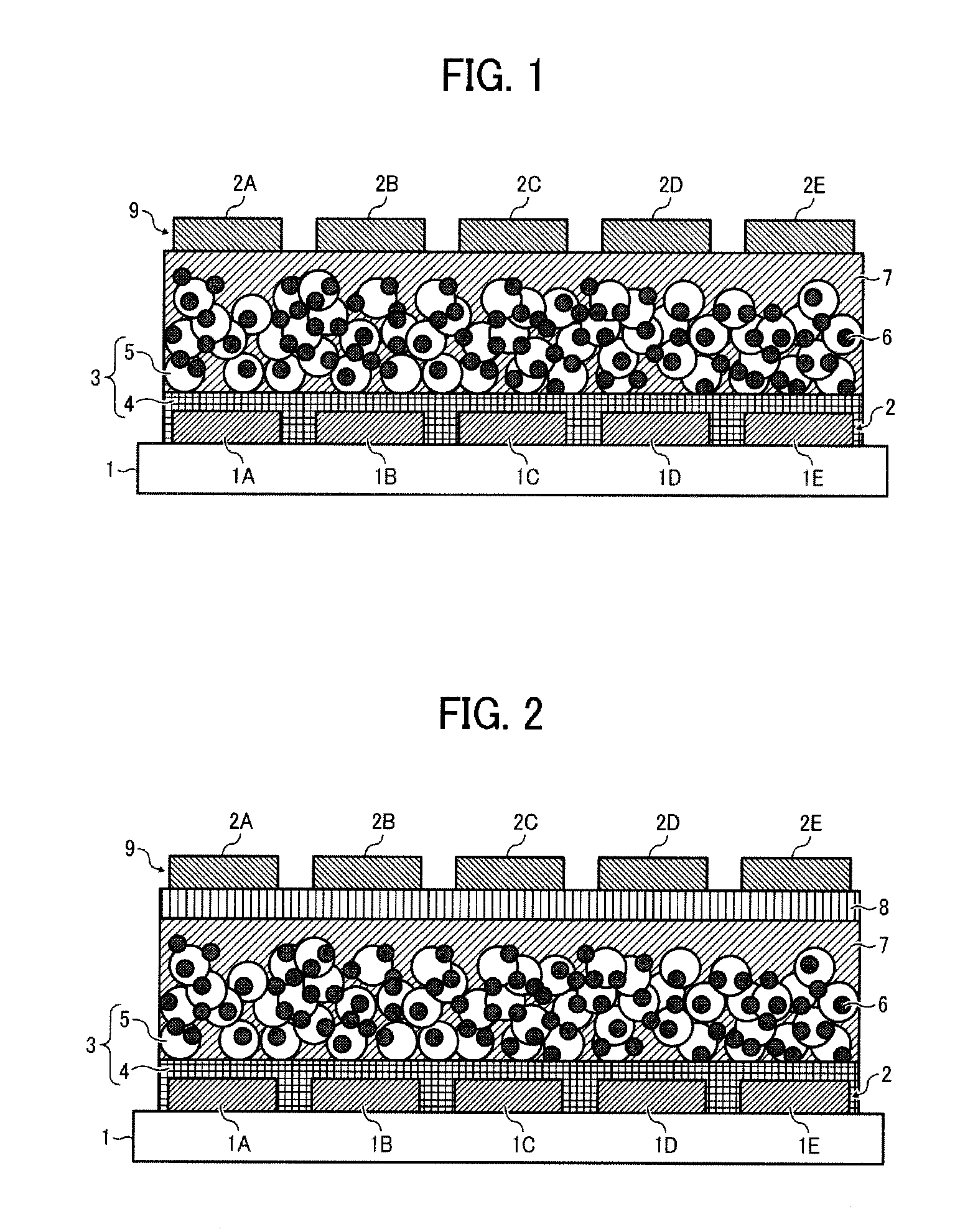Solid dye sensitization type solar cell and solid dye sensitization type solar cell module
a solar cell and solar cell technology, applied in the field of solid dye sensitization type solar cell module, can solve the problems of low efficiency of electric power generation, factor impeding widespread use, and high cost of present solar cells typified by silicon-based solar cells
- Summary
- Abstract
- Description
- Claims
- Application Information
AI Technical Summary
Problems solved by technology
Method used
Image
Examples
example 1
[0127]As shown in FIG. 4, an ATO substrate (from Geomatic Co. Ltd.) is subjected to an etching process. A combined solution of 2 mL of titanium tetra-n-propoxide, 4 mL of acetic acid, 1 mL of ion exchanged water, and 40 mL of 2-propanol is spin coated onto the ATO substrate and dried at room temperature. After drying, the coated ATO substrate is fired at 450° C. in air for 30 minutes. Accordingly, a compact electron transport layer having a thickness of approximately 100 nm is formed on the ATO substrate serving as an electrode.
[0128]Next, 3 g of titanium oxide (ST-21from Ishihara Sangyo Kaisha, Ltd.), 0.2 g of acetylacetone, 0.3 g of a surface-active agent (polyoxyethyleneoctylphenyl ether from Wako Pure Chemical Industries, Ltd.), 5.5 g of water, and 1.0 g of ethanol is subjected to a bead mill process for twelve hours to obtain a dispersion liquid. 1.2 g of polyethylene glycol (#20,000) is added to the obtained dispersion liquid and a paste is prepared.
[0129]As shown in FIG. 5, t...
example 2
[0133]A solid dye sensitization type solar cell of Example 2 having five cells connected in series with the configuration shown in FIG. 1 is prepared. The employed materials are the same as Example 1. The first electrodes and the second electrodes are connected as follows: the first electrode 1A and the second electrode 2B; the first electrode 1B and the second electrode 2C; the first electrode 1C and the second electrode 2D; and the first electrode 1D and the second electrode 2E.
[0134]The procedure of irradiating pseudo sunlight with the solar simulator as in Example 1 is repeated. The pseudo sunlight is irradiated on the solid dye sensitization type solar cell of Example 2 and voltage increase is measured. An open-circuit voltage of 4.05 V is obtained. An open-circuit voltage of approximately 0.8 V is obtained from a single cell. Accordingly, it can be understood that, due to five cells connected in series, an open-circuit voltage of five times is obtained.
example 3
[0135]A solid dye sensitization type solar cell of Example 3 having cells connected in series as in Example 1 except for replacing the Compound 1 with the following Compound 2 is prepared.
[0136]The procedure of irradiating pseudo sunlight with the solar simulator as in Example 1 is repeated. The pseudo sunlight is irradiated on the solid dye sensitization type solar cell of Example 3 and voltage increase is measured. An open-circuit voltage of 1.60 V is obtained. An open-circuit voltage of approximately 0.8 V is obtained from a single cell. Accordingly, it can be understood that the solid dye sensitization type solar cell of Example 3 is operating connected in series in the same way as Example 1.
PUM
 Login to view more
Login to view more Abstract
Description
Claims
Application Information
 Login to view more
Login to view more - R&D Engineer
- R&D Manager
- IP Professional
- Industry Leading Data Capabilities
- Powerful AI technology
- Patent DNA Extraction
Browse by: Latest US Patents, China's latest patents, Technical Efficacy Thesaurus, Application Domain, Technology Topic.
© 2024 PatSnap. All rights reserved.Legal|Privacy policy|Modern Slavery Act Transparency Statement|Sitemap



